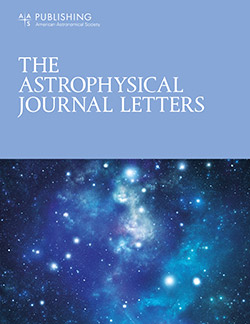围绕I类源CrA-IRS 2的7000 au原恒星气体环的alma分辨率视图,作为磁通平流的可能标志
IF 8.8
1区 物理与天体物理
Q1 ASTRONOMY & ASTROPHYSICS
引用次数: 0
摘要
在恒星形成过程中,从致密云核转移相当一部分磁通量是必不可少的。磁通损失产生的环状结构已在理论上得到了预测,但尚未提出观测鉴定。我们对南冕恒星形成区的I类原恒星IRS 2进行了ALMA观测,并在c18o (J = 2 - 1)线发射中发现了一个独特的气体环。这个气体环的中心距离原恒星约5000天文单位,直径约7000天文单位。从速度场(矩1)图和位置速度图判断,该气体的径向速度与原恒星的径向速度相差小于1 km s−1,具有可能的膨胀特征。这些特征要么是观测上的新发现,要么是已经发现的,但没有深入讨论,因为它们很难用研究得很好的原恒星现象(如分子外流和吸积流光)来解释。一种合理的解释是由磁通量平流产生的磁壁,理论上预计在恒星形成期间的0/I类阶段作为磁通量的消除机制。在其他年轻恒星源中报道的类似结构可能是由相同机制形成的候选者,这鼓励我们从观测的角度重新审视恒星形成早期阶段的磁通量传输问题。本文章由计算机程序翻译,如有差异,请以英文原文为准。
An ALMA-resolved View of 7000 au Protostellar Gas Ring around the Class I Source CrA-IRS 2 as a Possible Sign of Magnetic Flux Advection
Abstract Transferring a significant fraction of the magnetic flux from a dense cloud core is essential in the star formation process. A ringlike structure produced by magnetic flux loss has been predicted theoretically, but no observational identification has been presented. We have performed ALMA observations of the Class I protostar IRS 2 in the Corona Australis star-forming region and resolved a distinctive gas ring in the C 18 O ( J = 2–1) line emission. The center of this gas ring is ∼5000 au away from the protostar, with a diameter of ∼7000 au. The radial velocity of the gas is ≲ 1 km s −1 blueshifted from that of the protostar, with a possible expanding feature judged from the velocity-field (moment 1) map and position–velocity diagram. These features are either observationally new or have been discovered but not discussed in depth because they are difficult to explain by well-studied protostellar phenomena such as molecular outflows and accretion streamers. A plausible interpretation is a magnetic wall created by the advection of magnetic flux, which is theoretically expected in the Class 0/I phase during star formation as a removal mechanism of magnetic flux. Similar structures reported in the other young stellar sources could likely be candidates formed by the same mechanism, encouraging us to revisit the issue of magnetic flux transport in the early stages of star formation from an observational perspective.
求助全文
通过发布文献求助,成功后即可免费获取论文全文。
去求助
来源期刊

Astrophysical Journal Letters
ASTRONOMY & ASTROPHYSICS-
CiteScore
14.10
自引率
6.30%
发文量
513
审稿时长
2-3 weeks
期刊介绍:
The Astrophysical Journal Letters (ApJL) is widely regarded as the foremost journal for swiftly disseminating groundbreaking astronomical research. It focuses on concise reports that highlight pivotal advancements in the field of astrophysics. By prioritizing timeliness and the generation of immediate interest among researchers, ApJL showcases articles featuring novel discoveries and critical findings that have a profound effect on the scientific community. Moreover, ApJL ensures that published articles are comprehensive in their scope, presenting context that can be readily comprehensible to scientists who may not possess expertise in the specific disciplines covered.
 求助内容:
求助内容: 应助结果提醒方式:
应助结果提醒方式:


